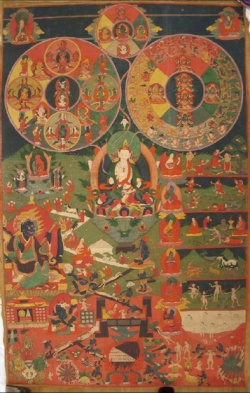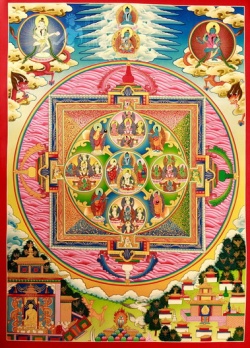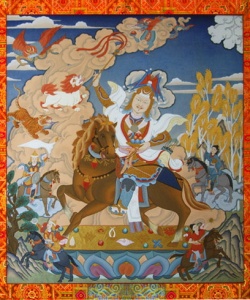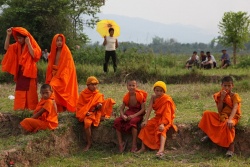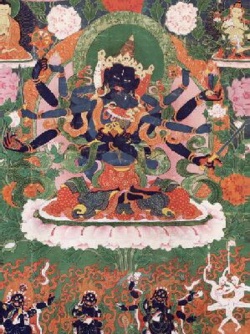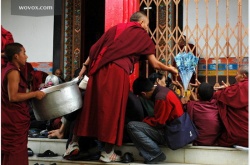Tibetan Embryology by Dr. Pasang Y. Arya
Embryology (Chhagstshul-rigpa)
Embryology is described in the second tantra and elaborated in its commentaries. It is especially detailed in the dGahvo-mngal’juggi-mdo, the ‘sutra of conception‘ expounded by Buddha to his disciple Ananda[1]. Some information also taken from the tantras gives light and clarifications. Therefore the Tibetan embryology is remarkably detailed and full of information concerning the body/mind, energy and subtle anatomy.
1. Conception (mNgaldu-rnamshes-‘jugtshul)
Life and body begin their development right after the conception in the mother’s womb, where the five basic and subtle elements start to be transformed into the physical body. According to the conception theory, the Bardo consciousness and the two parents are brought together by the emotion of the Bardo consciousness. When the Bardo consciousness sees the scene of a couple having sexual contacts, it also feels emotions, and desires to touch or hug the woman or man according to its karmic background. If the Bardo consciousness is going to get a female body in this next life, it feels attraction for the man and jealousy against the woman, while if the Bardo consciousness is going to get a male life, it feels desire to hug and touch the woman and hate for the man. At that time, the Bardo consciousness does not actually know who this man and woman are, and that they are going to become its future parents. At that moment of hugging or touching with emotion, the Bardo consciousness enters through one of the father’s nostrils and goes along with the breath to eventually reach sperm. The sperm and consciousness finally joins with the ovum. At the union of mind and matter, the state of mind is described in tantra as a great bliss and ecstasy, and this meditative stage is called ‘great absorption stage’. If the child is going to be male, the consciousness enters through the right nostril of the father, while for a female it enters through his left nostril. However, after that, the Bardo consciousness falls into coma or loses consciousness. It remains in this state of fainting until the 25th week after the conception.
The force of karma drives the power of attraction between the two parental physical energies and the consciousness; it is like magnet and iron, or earth and sky. On the 25th week, the child’s respiration (through the mother) starts and the sense of feeling begins. The consciousness wakes up on the 26th week and remembers some experiences of the past that happened during Bardo and even past lives. Due to the different karmas and fortunes, different phenomena arise during the conception time. Some Bardo consciousnesses experience tranquility and others pass through tragic emotions. The different Bardo emotions and traumas could influence the child’s behavior, psychology and personality after the birth.
After the conception, the embryo’s two energies continue to develop even during the mind fainting state. During this period, the psycho-physic dimensions of the basic body/mind structure are produced by the subtle wind energy. Tibetan medicine and the ‘sutra of conception’, dGahvo-mngal-‘juggi-mdo describe:
2. Fertility (Chhagspai-rgyu)
According to Tibetan Medicine, fertility does not only depend on the two parental energies, as especially the Bardo consciousness is also a prime factor. The fundamental theory of Tibetan medicine and Buddhism says that, without the Bardo consciousness, a child could not be conceived. But to get a new life, there are five factors that must actually be present during the conception.
- The five subtle and basic (gross) elements must be present in harmony and ready to collaborate. * A favorable karmic connection must have reached maturity.
- A Bardo consciousness must be searching for a new life.
- The parents' two energies must be of good quality.
- The menstrual cycle must be regular and well functioning.
If all the factors are ready, the conception can take place after the third day of menstruation. The lack of any of the required conditions, even when there is no physical organic disorder, could lead to infertility.
2.1. The elements (‘Byungwa-lnga)
The elements are in two sections:
1. Five subtle elements (Phrawei-rlung-lnga)
The five subtle elements are a very subtle energy form of earth, water, fire, air, and ether or space that accompany the mind. They are a part of the mind itself. This wind is so subtle that it is beyond the human physical experiment; it is the dynamic material force behind the development of the body as well as the whole world existence. It is a concept similar to that of genes in western science that transmit heredity. The difference between western science and Tibetan medicine on this issue is that Tibetan medicine accepts that the external objects are also products of the mind and elements, whereas science neglects the aspect of the mind. The elements are also the causal bodies of the five Dhyani Buddhas[2] and their five colors of white, red, blue, yellow and green. The elements unite and transform themselves into the three-dimensional energy that produces the body, mind and speech of the being. To conceive a child, the subtle wind energy of the mind should be well balanced in order to give a healthy body and mind, and allow them to harmoniously develop. If the subtle elements are in disharmony during the conception, it may influence the child’s development, which could then manifest genetic or congenital disorders.
First element
According to the element formation process, the first element is space and its particles are the basis of all the others. Space (ether) is filled by a subtle material energy form that produces what is called ‘space element particles‘. The space particles produce the wind element particles, which are less subtle, and that further produce fire; Fire produces the water element, which, in the last, produces the earth element particles. Throughout this sequence, from space to earth, these material particles become less and less subtle. Earth is the most solid element; it holds the center of the world and forms the different existences. Similarly, spleen and stomach, which are earth element organs, hold the center of the body in Medicine. These five elements are called ‘basic elements.‘ Buddhism believes that the space particles will remain in space until the collective karma of the beings has vanished; therefore it means that it will remain for eons and eons.
| Dhyani Buddhas | Subtle wind's five elements |
Colors | Chakras | Solid organs | Emotions |
| Vairochana | space | white | crown | heart | ignorance |
| Amitabha | fire | red | throat | liver | attachment |
| Akshobya | water | blue | heart | kidney | anger |
| Ratnasambhava | earth | yellow | navel | spleen | pride and greed |
| Amoghasiddhi | wind | green | secret | lungs | desire |
2. Five basic elements (‘Byungwachenpo-lnga)
The physical body is produced from the material and sub-material (subtle) of the five basic elements. They are the same as the subtle elements described earlier, and are concentrated in the parent’s two energies. The second tantra explains:
Basic tissues such as flesh and bones, as well as the nose organ and smell come from the earth element
Liquids of blood and lymph, brain, nerves as well as the tongue and taste are produced by the water element
The body temperature, color, as well as the eyes and vision come from the fire element
Respiration, skin, and tactility come from the wind element
The space element produces the body hollow organs, channels, orifices, external and internal body spaces, ears and sound, and pervades the whole body.
The child receives the elemental energies (nutrition) during the fetus development. The five elements (‘byungwa-lnga) are present in the food, water and air, and in everything that nourishes the child through the mother’s food nutrition. Therefore the presence of the five basic elements and their energy in harmony are of prime importance for the fetus development.
| Basic elements | Organs | Sense organs | Sense faculties | Sense objects |
| Space | heart/small intestine | ear | auditory | sound |
| Air | lungs/colon | skin | tactile | tangibles |
| Fire | liver/gall bladder | eyes | visual | visual objects |
| Water | kidney/urinary bladder | brain | tongue | gustatory taste |
| Earth | spleen/ stomach | nose | olfactory | smell |
2.2. Favorable karmic connections (Les’brel)
The concept of karmic connection is very important in Buddhism especially in the human development. Karma binds the relationships between body/minds; it is the power of the reunification of mind and matter, child and parents. The accumulated karma of the past life establishes the karmic connection with one’s future life and fortune, and directs the consciousness towards the future parents. Without a karmic connection, even with qualified energy of the couple and favorable conditions, the conception will not take place.
2.3. Bardo consciousness (Bardoi-sems)
The Bardo consciousness is a mental state between the past and the future life. The being is solely clothed with an illusory body or dream-like body (mental body), and is able to experience joy and suffering.
After the death of the past body, the Bardo state starts and the mind begins to travel in an unknown world. The Bardo mind can pass through material objects and move instantly to any place without being stopped by obstacles. The maximum Bardo duration is forty-nine days. During this period, the paths and desire of the Bardo being are directed by one's own karma to get a new life. Some Bardo beings get their new life within several days after death while some others get a new life within a very short period spent in the Bardo state. All depends on their past karmic results [3]. The consciousness enjoys or suffers depending on the illusions manifested in the state of Bardo. The psycho-illusory body is very light like a feather, and possesses a strong power of clairvoyance. The consciousness, driven by the karmic force, is able to reach any place in the world where the future parents are living. It sees the couple and is attracted to them like bees to flowers
2.4. Quality of the reproductive fluids (khukhrag-bzang-ngan)
The quality of the two parents reproductive fluids is a basic factor for the conception of the child. Physically, it is the primary factor for the conception's success or failure. Especially the mother’s menstruation quality is vital for the physical fertility, like that of the soil.
There are qualified and unqualified qualities of the parents energies (sperm and ovum). rGyud-bzhi describes the following two positive qualities that could give birth to a healthy child:
- The menstruation should be like a red colored lac or like a rabbit’s blood, and be washable by water.
* The man’s semen should be whitish, heavy, sweet, and in a large amount.
The following negative qualities of the menstruation will prevent a conception.
- A menstruation disturbed by a wind disorder, which then has a rough quality, a dark color and an astringent taste.
- A Bile disorder contaminated menstruation, which is yellowish and has a sour taste, with a bad smell.
- A Phlegm disorder contaminated menstruation, which is sticky like mucus, and has a sweet taste and a low temperature.
- A blood disorder contaminated menstruation, which is like being decayed.
- Phlegm and Wind disorders, that produce menstruation divided in small parts (clotting)
- A blood and Bile disorder contaminated menstruation, which becomes like pus.
- A Phlegm and Bile disorder contaminated menstruation, which becomes like nodes.
- A Wind and Bile disorder contamination that dries up the menstruation in the womb (early natural menopause or untimely released menstruation).
- A total combined humors contamination, which shows mixed menstruation like feces and urine.
Any of these menstruations cannot support the conception of a child.
Negative quality of the man’s semen
- The semen that contains a poor amount of spermatozoa, which tends to be found in the Wind/Phlegm constitution.
- Unusual spermatozoa formation
- Lazy and weak spermatozoa
Any of the parents poor or unqualified reproductive fluids described above could prevent the conception or may give a handicapped child if fertilized. The picture is given here in the geriatric chapter; “A poor or unqualified man’s semen is like a bad quality seed that can’t give birth, and an unqualified menstruation is like a bad field which cannot support the seed to grow.”
2.5. Menstrual cycle (Zla-mtshan)
The menstruation cycle is a very important function in the conception process. The menstrual cycle starts when they are around twelve years old, and continues till they reach around fifty. It is called Zla-mtshen, which means ‘monthly sign‘. It is the sign of energy discharged under the form of menses according to the woman’s individual body clock. Cycles and ovulation time differ from one woman to another. It is her personal body clock, which mainly corresponds to the lunar calendar. Before twelve years old, women need the energy to develop the physical body, so no menses are produced. The beginning of menstruation is the sign of puberty and adolescence, and that the physical development is generally completed. After fifty years old, women enter then in the menopause stage. Again, nutrients are needed for the body sustainment, so menses cease.
Dysmenorrhea and amenorrhea, physical disorders, unqualified menses etc. can be obstacles to fertility. Menstruation is a symbol of the sun energy (fire) while sperm has moon energy. They are the earth and sky nature that can produce anything if they are in favorable conditions. The menstruation cycle follows the lunar phases and generally produces ovulation during the waxing moon, and menses are mostly discharged during the waning moon.
The Tibetan traditional concept on general menstruation time is based on the Tibetan lunar calendar. Desid Sangye Gyatsho’s Bedurya Malika commentary on the second tantra describes: “From day 16 to day 30 (first day of the waning moon to the dark moon), it is the when the solar energy increases and therefore generally women produce menstruation in the ovary for two waxing weeks. From day 1 to 15 (first day of the waxing moon to the full moon), the lunar energy increases and most women begin to collect the menstruation from ovary through the fallopian tubes to the uterus for two waning weeks. The uterus begins to open its door when the menstruation reaches t. ”Tibetan medicine generally does not distinguish the ovum and menstruation. The concept is like apple and seeds, they grow together. Therefore literatures mainly use only zla mtshan or monthly sign for menstruation. But for the man’s sperm, there are two separated names: khuwai ‘bu, or sperm, and khu chu for the liquid.
2.6. Traditional theory of child conception (Ngal’zinpai-dus)
Probably from Yuthok Yonten Gonpo the younger (12th century) up to this century, many debates and researches have been done on the subject of conception. However, with time and development of new understandings on human biology with modern scientific knowledge, much more information on human physiology functions have been acquired. These developments have created some doubts and also have clarified many hidden things in some areas of the rGyud-bzhi. For example, a simple question case such as the ‘time of conception of child’ developed in Tibetan Medical history. On that point, the ancient literatures and modern western interpretation on conception are very different, even if Tibetan physicians unanimously accept that the possible time for the conception starts on the 3rd day after the beginning of menstruation. Numerous books on Tibetan Medicine have been published recently with the modification of the conception time, while some others have kept it as it was. The point of changes and new interpretation are:
1. Ancient concept and interpretation: The traditional Tibetan Medicine teaching continues to keep its literal explanation of the commentary of rGyud-bzhi on the conception time, which states:
“The conception will not take place on the first three days of the menstruation and also on the 11th day after the three first days of the menstruation. The conception taking place on odd days only (1,3,5,7,9) will give a male child; if the conception takes place on even days (2,4,6,8) a female child will be born. The womb will close its door after the 12th day like the lotus after the sunset” (the counting day system begins after the 3rd day of menstruation, which means that the 4th day is considered the first day of possible conception).
The literal explanation says that the first three days are menstruation time and sexual intercourse should be avoided. It also says that on the 11th day, a male child won’t be conceived, but that a female child could be conceived. To get an easy comprehension see the following table:
| General conception days |
First three menstruation days |
4th day after menstruation (counts as 1st day) |
Day | |||
| Male | - | 1st day | 3rd | 5th | 7th | 9th |
| Female | - | 2nd day | 4th | 6th | 8th | |
This concept is also shared in the Buddhist saint Phakhol’s (Vagbhata) Astangahrdaya, one of the most leading Ayurvedic medical texts, which was translated into Tibetan by Indian Pandita Jarandhara and Lotsawa Rinchen Sangpo in the 11th century A.D. Especially the Vagbhata’s commentary Astangahrdaya-nama-vaiduryakabhasya, translated by the Indian Pundita Dharmashrivarma and the Tibetan translator Sakya Lodoe, gives details on the subject. The tantric literatures also give the same information. Therefore it is the general concept stated by ancient Asian spiritual, cultural and medical sciences. In this context the conception will not take place during the ovulation time.
Secondly a new explanation was recently developed in Tibet. Interestingly, it uses the same text but with a different understanding. The new interpretation states that, “The conception will not take place during the first three days of menstruation nor on the eleven following days. After the 14th day (from the menstruation start) the conception begins. If it takes place on the odd days 1,3,5,7,9 a male child will be born, while conception on even days 2,4,6,8 will give female child”. In short, the second concept accepts that the conception may happen during the ovulation time. The interpretation is closer to the modern scientific concept on the subject.
2.7. Sign of conception (mNgal-‘zinpai-rtags)
As a sign of conception, the woman immediately feels heaviness and satisfaction. After one month or two, the pregnancy syndrome begins with headache, nausea, body ache and sometimes desire for special food, etc. These symptoms are considered as being normal. The pregnant woman should be helped morally, and only if necessary, be given a light treatment. Generally it is safer to avoid any treatment and surgery.
Precaution during the pregnancy
Traditionally a pregnant woman should avoid eating particular meats that do not belong to her culture or for which she doesn’t have interest. For example beef in India and horse, donkey or dog meat in Tibet, etc. as it might bring a negative psychological effect, which could influence herself and the child. Therefore Tibetan medicine advises the pregnant woman to avoid eating horse, donkey, and various birds meat. Generally, the pregnant woman is psychologically sensitive and fragile, therefore she should also avoid harmful emotions, and keeping harmony around her is important.
3. Development of the embryo (Lus-‘pheltshul)
The fetus development starts just after the conception, lasts thirty-eight weeks, and develops through three significant stages that resemble to fish, turtle and pig. The basic source of development is the mother, as she gives nutrition to the fetus through the umbilical cord via the placenta.
3.1.Development process
First month
The 1st day of the first week after the conception is the time of fertilization. The mixed sperm and ovum is like a drop of yeast mixed with milk. A subtle wind, called Myonmongpei-yid-srog-rLung-A[4], manifests from the mind consciousness (Srog-rlung-A: subtle wind of the mind. During the next weeks, winds are going to manifest from this wind). It harmonizes the elements and energies of the parents to develop the body.
2nd week a subtle wind called Kuntu-sdudpa manifests from Srog-rLung-A and begins to mix the two energies together (sperm and ovum). The fertilized ovum becomes a little thicker and longer.
3rd week a subtle wind called mZodka manifests from the Srog-rLung-A and helps the two energies mix totally and the fertilized ovum becomes like curd[5].
4th week a subtle wind called Leskyi-rLung-mngonpar-sdudpa manifests from the same wind Srog-rLung-A and begins to develop the fertilized ovum into a round, oval or elongated shape, according to the child’s gender (male, female or neutral (hermaphrodite) sexes respectively).
Pregnancy signs
During this week, the child’s gender develops and the pregnancy syndrome appears with vomiting, various desires, etc. Tibetan medicine says that these symptoms manifest from the child’s needs for his/her development. Therefore one should not repress the longing for special food, or emotions, even if they produce some troubles. Preventing the consumption of the desired food and drinks may harm the child’s physical development.
2nd month
5th week a subtle wind called Yangdagpar-sdudpa manifests and begins to develop the child’s navel and navel chakra, in the center of the body. This stage is called ‘beginning of the fish stage’[6] because the fetus develops a fish-like shape.
6th week a subtle wind called rGyachhenpo manifests and helps develop from the navel the central channel of the body, like a growing sprout.
7th week a subtle wind called ‘Khyilwa manifests and helps develop all the three channels (right, left and central) and forms the eyes organ in the head, and the crown chakra first, then the heart and secret chakras.
8th week a subtle wind called zlogching-bsgyurwa manifests and helps form the throat chakra, and shapes the head.
9th week a subtle wind called rNampar-byedpa manifests and helps develop the upper and lower body abdomen. This stage is the end of the first section of the development stage and is called ‘completing the fish stage’.
3rd month
10th week a subtle wind called Srawar-byedpa manifests and helps the protrusion of the two shoulders and hips. This week is called beginning of the ‘Turtle stage’ because the child's body shape looks like a turtle.
11th week a subtle wind called Buga-snangwa manifests and helps form the nine internal orifices of the body. They are eyes, ears, nostrils, mouth, and feces and urinal channels (secret chakra).
12th week a subtle wind called Yoenpoi-sgo manifests and helps form and shape the five solid organs.
13th week a subtle wind called Bur-rgyuspa manifests and helps form and shape the six hollow organs.
4th month
14th week a subtle wind called sKudpaikha or sgo manifests and helps form and shape the upper arms and thighs.
15th week a subtle wind called Padma manifests, helps form the arms and make calves protrude.
16th week a subtle wind called bDudtsi-‘growa manifests and helps protrude the twenty fingers and toes.
17th week a subtle wind called ‘Bri-gdong manifests and helps the progression of the development of the three principal channels and connective branches of nerves, blood and lymph vessels. This moment is called ‘completion of the turtle stage’.
5th month
18th week a subtle wind called Drima-medpa manifests and helps develop flesh and fat tissues. As it is the beginning of putting on weight and tissues, this week is called beginning of the ‘Pig stage’. The fetus desires for food and experiences hunger.
19th week a subtle wind called Shintu-phrawa manifests and helps develop all the ligaments, tendons and nerves.
20th week a subtle wind called Shintu-brtanpa manifests and helps construct the bones, bone marrow and white matters.
21st week a subtle wind called Yangdagpar-bskyodpa manifests and helps develop the skin and tactile constituents.
6th month
22nd week a subtle wind called Kuntu-rgyalwa manifests and helps open and shape the nine external orifices.
23rd week a subtle wind called Yongsudagpar-‘zinpa manifests and develops hair, body hair and nails.
24th week a subtle wind called Kuntu-phyowa manifests and develops and makes the five solid and six hollow organs mature. The fetus begins to feel joy and sorrow.
25th week a subtle wind called Grongkhyer-‘zinpa manifests and the respiration starts.
26th week a subtle wind called sKyewa-mngonpar-grubpa manifests and the child begins to wake up from his/her deep fainting, and remembers his/her past lives.
7th month
27th till 30th weeks
each week manifests a different subtle wind called sMen-yon-chhenpo, Metog-‘zinpa, Metog-phrengwa, and Chagskyi-sgo. These winds help develop and strengthen organs, tissues and channels. In short, all body parts, gross and subtle, complete their development. The body becomes like a well-built palace and the mind begins its mental function.
8th month
31st till 35th week
during these five weeks, only one subtle wind called Metog-sdudpa manifests and helps grow the child’s body. This period is called ‘completion of the Pig stage‘. During these days, there is a competition or struggle between the mother and child to get the energy of mDang. The body radiance and complexion energy of the child and mother are alternately dominant. Generally this is not the right time for giving birth but, due to certain conditions, the delivery may occur and be a danger for the health of the mother or child. During these weeks, the child completes his/her body development, and hair, body hairs, nails, etc. continue to grow. This stage is called ‘pig stage’ because the child, like pig, desires to eat with lacking of knowledge about the edible food.
9th month
36th week the child begins to experience the five feelings of sadness that give condition and influence his/her mind to come out and become independent.
- The place (womb) is unclean
- There is an unpleasant smell
- It is like a prison
- It is dark and
- The child feels unhappy to live inside like in a cage.
37th week because of this sadness, the child wishes to move and go out from the womb so he/she begins to turns down.
38th week a subtle wind called Thogspai-rkyen manifests and with the help of the ‘descendent wind‘ Thursel-rlung, the child moves outside the uterus and delivery begins. The child’s delivery shows that the body of the human being has been produced, developed, matured and completed. The body/mind now needs to grow with food, care, clothing, education and experience, to become a complete person able to live consciously.
Delivery and obstacles (skye-mithubpei-rkyengsum)
Generally, after a normal pregnancy time, which lasts around nine months and ten days from the conception, it is considered the right time to give birth.
The embryology chapter describes that there are three obstacles for the birth, which can delay the delivery or create other delivery difficulties.
First obstacle: The delivery will be delayed if the mother has lost blood during the pregnancy time.
Second obstacle: If the child has grown too big, the delivery could be delayed, and it might cause risk for the mother and child’s lives.
Third obstacle: If the ‘descendent wind‘ (Thursel-rlung) is disturbed, the normal delivery could be blocked and delayed.
All these cases need help of a physician or a midwife, as they may be extremely dangerous for the mother and child’s lives.
How to help the pregnant woman
Emotion and mood naturally change in some women when they get pregnant. The family should not mind about this, as these are natural changes. After the second month of the pregnancy, the woman is advised to avoid surgery, bloodletting therapy or strong medication. She especially should not use toxic and purgative substances.
The pregnancy syndrome of desire for eating sour taste and various specific food and drinks should not be restrained as it comes from the child’s needs for his/her development.
From the seventh month till before labor, sesame or mustard oil massages in the lower back, thighs, legs and feet are useful to smooth the descendent wind and harmonize the elements in the lower abdomen. The eighth month is an important time for physical movements, because it helps make the delivery time easier. The woman should regularly see the doctor or midwife for a checkup.
During delivery time, when the rhythmic pain starts e.g. every hour, Tibetan tradition physicians give the Tibetan medical product Agar35 and Shije11 alternatively with strong black tea. This medicine shortens the contractions rhythm, reduces the delivery pain, and relaxes the tension and muscle contractions of the uterus. It controls the ‘descendent wind‘ function, which is generally disturbed by fear and pain of labor. After the delivery, another herbal pill, Shije6, helps clean the uterus and expel the placenta easily. The mother should recover with good care and moral support with compliment and comfort from the family; she should relax and recover from tiredness. Traditionally, during one week after the birth, the mother is not allowed to take cold bath nor touch cold cement or earth with bare hands in order to prevent from early osteoporosis and chronic kidneys, lower back, and cold diseases. After the birth, the child should be given a name chosen by the family, and brought up with love and care[7].
Footnotes
- ↑ Dr. Karma Thrinley’s selection work on Luskhams-nyimei-gnyenpo, told by Buddha to his cousin and disciple Ananda (Kun-dgahvo), and translated in Tibet. The present text is based from the Indian translation from sanskit, re-published in autonomous Tibet of China in 1993. Generally there are two translations (Indian and Chinese) of the ‘sutra of conception‘ (dGhavo-mngal-‘juggi-mdo) in the Tibetan Kagyur. These translations are slightly different but their meaning is similar. These texts could be two of the most comprehensive texts on the subject, and of great value for the researchers in the field of human life and human biology.
- ↑ The five Dhyani Buddhas are the enlightenment body, speech, mind, quality and action of an individual Buddha. It is also called ‘five Buddha family‘.
- ↑ See details in “The Tibetan Book of the Dead”.
- ↑ Srog-rLung-A is a subtle wind element of the mental consciousness. It is an energy aspect of the mind that makes the ‘life sustaining wind‘ and different other winds manifest at each embryological development stages.
- ↑ In this stage, one can change the gender or plan the sex of the child. There is a lengthy method of ritual described in the second tantra commentary. It is also described in the Astangahrdaya.
- ↑ Hevajra tantra describes that the human child in the mother’s womb is similar to a pseudo Buddha, referring to the shaped head, innocent and pure heart, naked body (unconditioned), etc and this state is then qualified as pseudo-Buddhahood. The child’s development is also described in the Kalachakra Buddhist tantra.
- ↑ Three chapters on woman’s disorders and three chapters on pediatric concerning the child-mother health practices are detailed in the third tantra.


